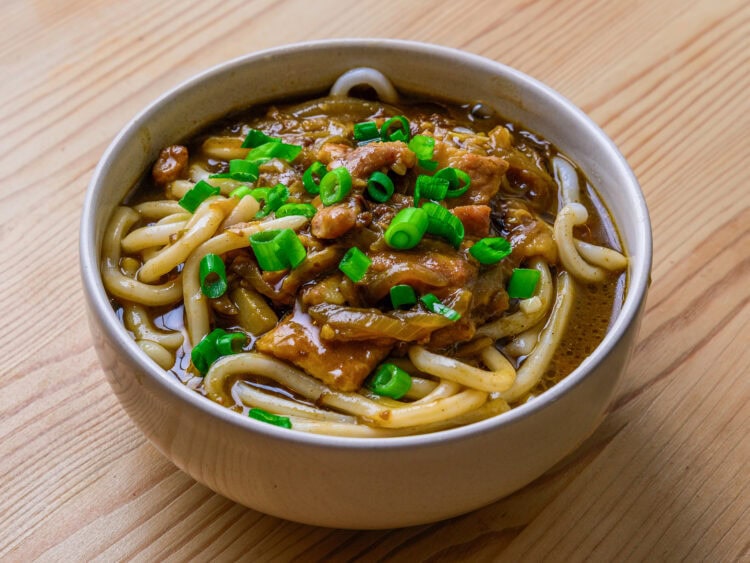A delicious Japanese recipe combining thick udon noodles with a delicious creamy and comforting Japanese curry
Curry udon (カレーうどん), sometimes also called kare udon or curry udon, is a perfect example of Japanese cuisine blending washoku (traditional Japanese cuisine) and yoshoku (Japanese cuisine with Western influences). This dish combines a traditional udon noodle soup with Japanese curry, a preparation imported from the West.
It appeared at the end of the Meiji era (early 1900s), when restaurants specializing in udon and soba sought to win back customers attracted to new establishments offering Western-style curry rice.
The Origins of Curry Udon
There are two main accounts regarding its origin: one places its birth in the Waseda district of Tokyo, the other in the Tanimachi district of Osaka:
Waseda Origin, Tokyo (1904):
Around 1904, in Tokyo near Waseda University, a soba restaurant named Sanchoan (三朝庵), run by Kato Asajiro, is said to be the first to have served curry udon (initially called curry nanban). Observing the popularity of curry rice, Kato had the idea to adapt this recipe to noodles. He created a broth by dissolving curry roux in a dashi made of bonito and soy sauce, thickened with potato starch, so that it would adhere well to the noodles.
His original dish included pork (considered inferior to beef and chicken at the time) and leek. Sanchoan is also famous for developing a custom spice blend with a local merchant. Although closed since 2018, the restaurant remains recognized by many as the true inventor (“元祖”) of curry udon.

Osaka Origin (1908–1909):
Another theory places the “origin in Osaka, in the Tanimachi district, around 1908-1909. Tsunoda Torinosuke, a soba artisan from Tokyo, opened the Tokyo Soba restaurant, where he initially struggled to attract local customers who preferred udon. Inspired by the craze for Western cuisine (yoshoku), he created a version combining soba and curry, called curry nanban. Tsunoda also developed his own spice blend. His recipe became a great success in Osaka and the Kansai region, before returning to Tokyo. Today, the Asamatsu-an (朝松庵) restaurant in Meguro (Tokyo) continues this tradition.”

In any case, by the Taisho era (1910s), curry udon and curry soba were already commonly featured on restaurant menus in both Tokyo and Osaka, indicating their rapid adoption. An important milestone was the registration in 1910 by Tanakaya (a supplier collaborating with Sanchoan) of the “Chikyu Mark portable curry powder,” thus confirming the commercial availability of a curry seasoning specially designed for noodles. Japanese culinary magazines of the time were already sharing curry nanban recipes, some of which have been recently rediscovered and recreated.
In short, historical documents (newspapers, company archives, encyclopedias such as the 蕎麦辞典 from 1972) all confirm that curry udon was born in the Meiji era as an inventive fusion: a dashi soup for udon combined with curry spices, thickened to obtain a slightly coating texture. The initial recipe, which is still a reference today, is based on a broth with a dashi base, seasoned with soy sauce, enhanced with curry powder (or in roux form) mixed with wheat flour, simmered with simple ingredients (meat, leek) and slightly thickened with starch to adhere well to the noodles.
Notable Variations of Curry Udon
Curry udon has different regional and stylistic variations in Japan. One of the most famous variants is Nagoya-style curry udon, locally recognized as an iconic specialty (“Nagoya-meshi”). Unlike the standard recipe thickened with starch (potato starch), the Nagoya version uses a curry roux based on wheat flour, dissolved in a rich broth combining chicken and bonito.
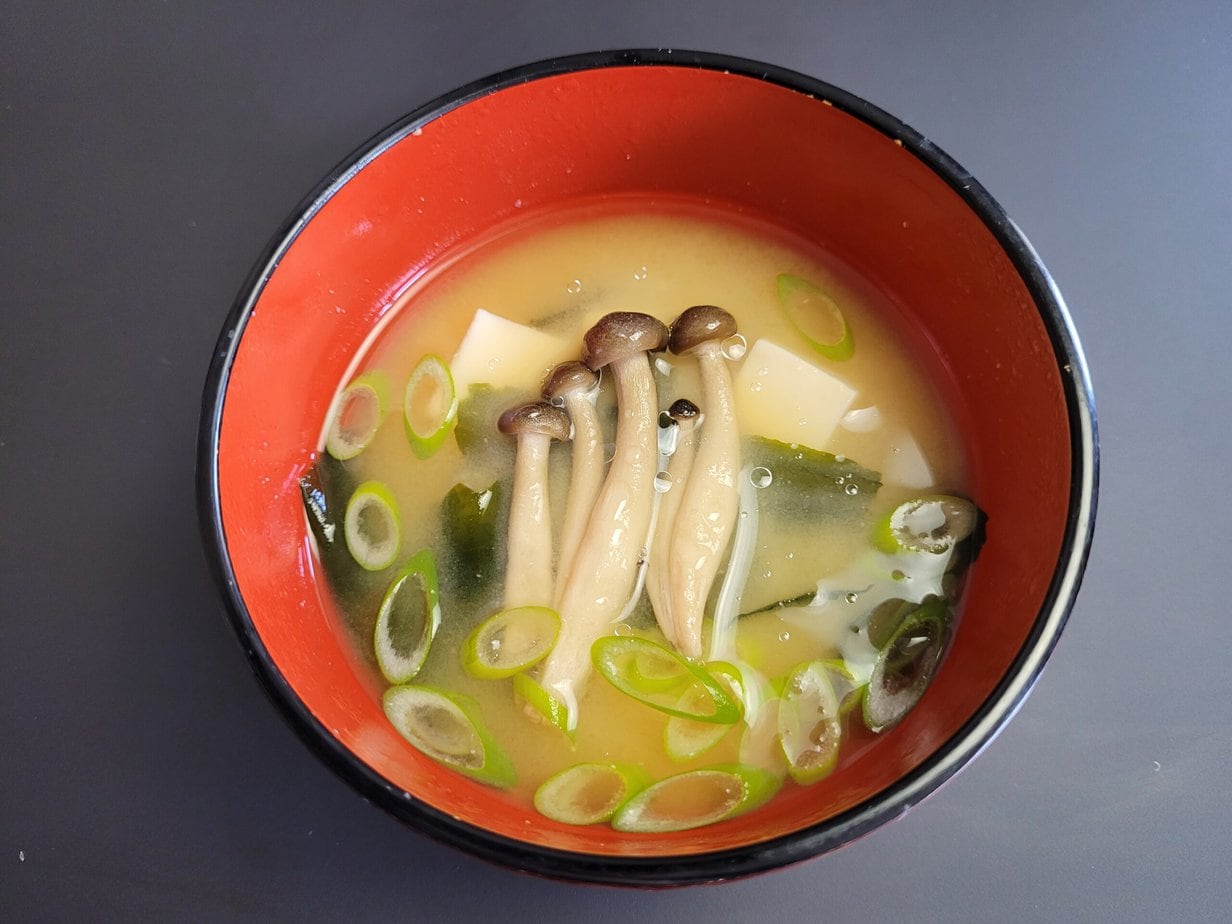
This results in a creamy soup, almost like a potage, with a particularly dense texture. Nagoya udon noodles are generally very thick and soft, ideal for accompanying this hearty soup. This recipe “became popular in the 1950s-1960s thanks to the use of” a local instant curry (Oriental Curry).
Besides this regional specificity, the standard styles of curry udon vary by region. In the “east, in Kanto (Tokyo), pork or sometimes chicken is often preferred, traditionally accompanied by Japanese leeks, while in the Kansai region (Osaka, Kyoto), beef is the favorite ingredient. Some even distinguish between ‘curry nanban’ (with negi) and classic ‘curry udon’ (more often based on” regular onions).
Finally, two major stylistic approaches coexist: the traditional authentic style (soba-ya restaurant), which relies on a fresh dashi made from bonito and kombu, enhanced with curry powder and slightly thickened with starch, resulting in a delicate, umami, and subtly spiced soup; and the family style, made with leftover Japanese curry from the day before, simply diluted with dashi or mentsuyu, resulting in a thicker and more rustic outcome, very popular at home, although less faithful to the restaurant version.
The Main Ingredients of Curry Udon
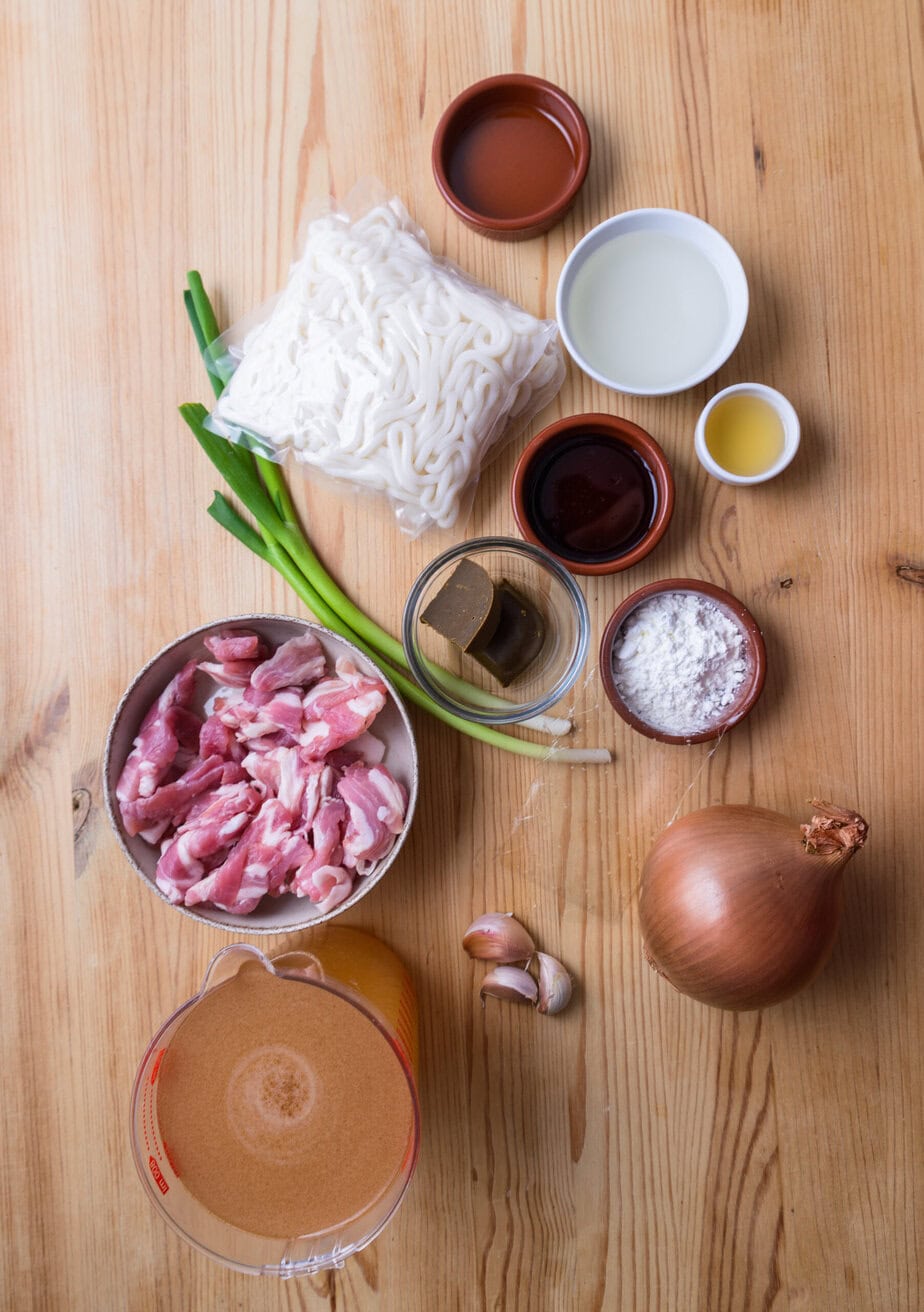
Udon noodles: Thick and soft, these Japanese noodles bring a comforting texture to the dish.
Light soy sauce: Adds a salty and umami touch to the marinade and broth.
Japanese sake: Gives depth and a slight sweetness to the broth.
Mirin: A sweet Japanese alcohol that balances the flavors of curry and dashi with a sweet touch.
Sesame oil: Adds a fragrant and slightly toasted note to finish the dish.
Dashi: Japanese broth made from kombu and dried bonito. Available in powder form.
The Japanese curry roux: Used to make the curry, you can easily buy it ready-made or make it at home
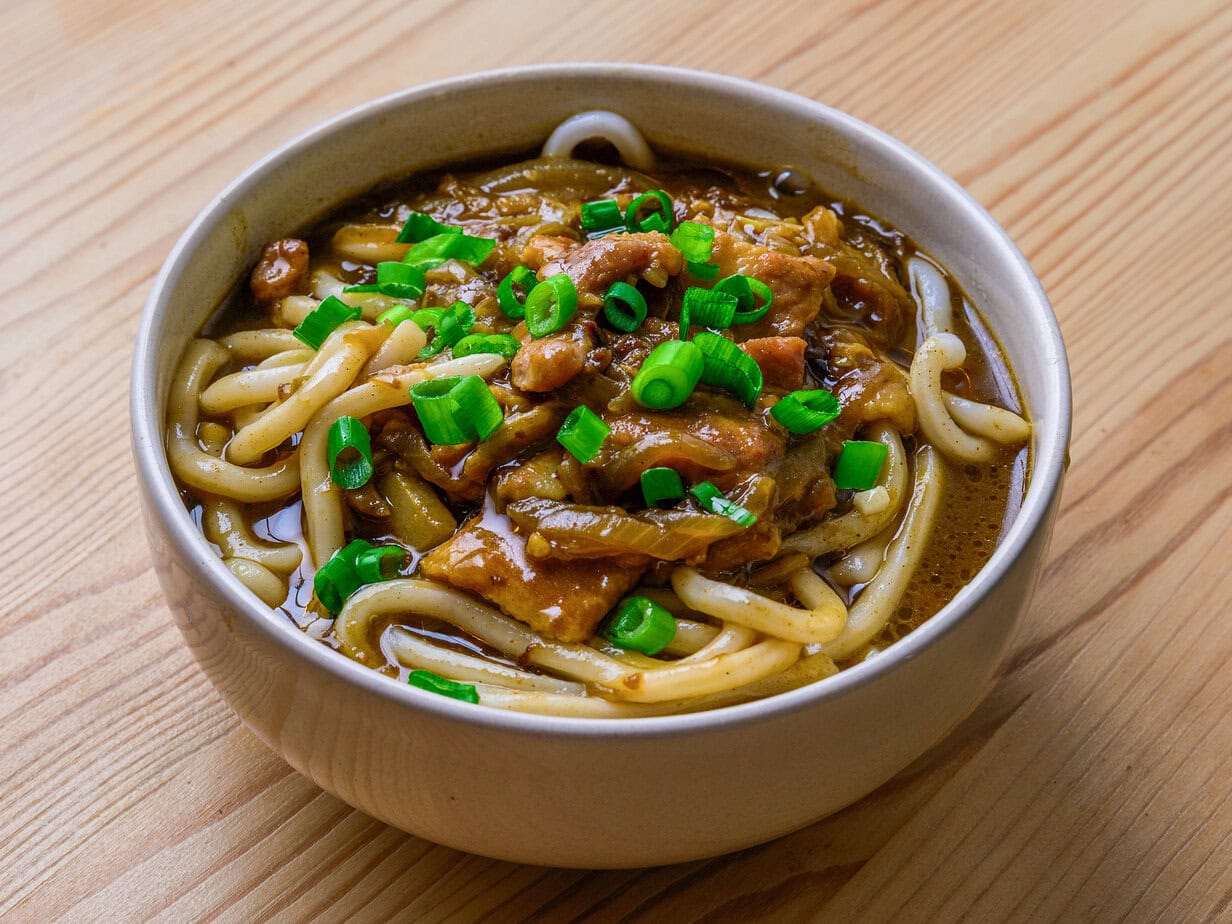
Authentic Curry Udon
Ingredients
- 200 g pork belly thinly sliced
- 2 portions of pre-cooked Udon noodles
Marinade
- 1 tablespoon light soy sauce
- 1 teaspoon cornstarch
Bouillon
- 700 ml of dashi homemade or from powder
- 2 cubes of Japanese curry roux
- 2 tablespoons of sake
- 2 tablespoons light soy sauce
- 1 tablespoon of mirin
- 2 leaves of gelatin
Vegetables and aromatics
- 1 onion thinly sliced
- 3 cloves garlic minced
- 2 stems of green onions sliced, green parts separated from white
Toppings
- Sesame oil
- Green parts of spring onions minced
Instructions
- Marinate the pork for at least 10 min200 g pork belly, 1 tablespoon light soy sauce, 1 teaspoon cornstarch
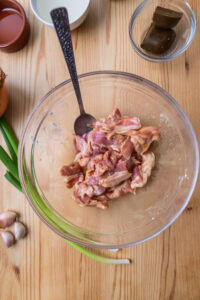
- In a wok, heat some oil over high heat
- Add the marinated pork
- Stir-fry until well browned and cooked, set aside
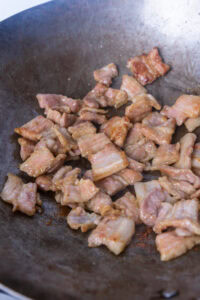
- Lower to medium-high heat, sauté the onions for a few minutes1 onion

- Add garlic and white parts of spring onions, stir-fry for 2 min3 cloves garlic, 2 stems of green onions
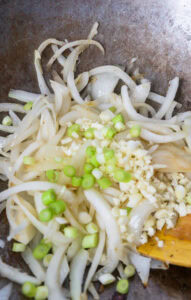
- Add dashi, soy sauce, sake, and mirin and bring to a boil700 ml of dashi, 2 tablespoons of sake, 2 tablespoons light soy sauce, 1 tablespoon of mirin
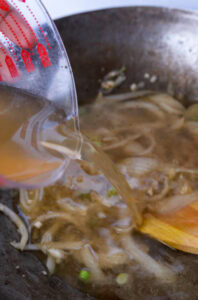
- Add the gelatin sheets2 leaves of gelatin

- When it’s boiling, take a ladle of broth in a separate bowl. Dissolve the roux cubes. Mix until completely dissolved2 cubes of Japanese curry roux
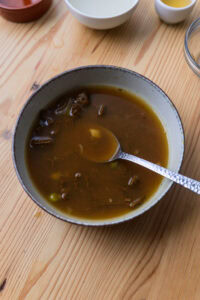
- Incorporate the dissolved cubes into the broth
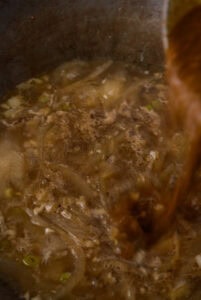
- Simmer covered for 15 min
- Meanwhile, prepare the udon according to package instructions and drain2 portions of pre-cooked Udon noodles
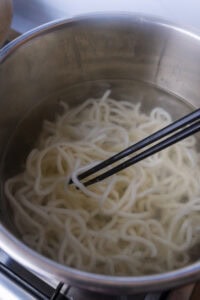
- Put the pork back into the broth and simmer for 5 minutes
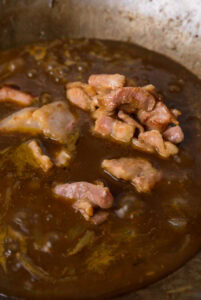
Plating
- In each bowl, place a portion of noodles
- Add broth over the top with the meat
- Add a drizzle of sesame oilSesame oil
- Add some sliced green onionsGreen parts of spring onions
Notes
Nutrition
Culinary sources
- https://ja.wikipedia.org/wiki/カレーうどん (カレーうどん – Wikipedia)
- https://news.nissyoku.co.jp/restaurant/grs-42-0015 (The fourth owner of Sanchoan, the origin of “Curry Nanban”, Mr. Hisatake Kato, speaks – Nippon Shokuhin Shimbun)
- https://japanesetaste.com/blogs/japanese-taste-blog/an-introduction-to-japanese-curry (An Introduction to Japanese Curry – Japanese Taste)
- https://tabelog.com/tokyo/A1305/A130504/13022123/dtlrvwlst/4497374/ (Considered the birthplace of curry udon, an old soba restaurant in Waseda – Tabelog)
- https://housefoods.jp/data/curryhouse/know/trends02.html (About the Origin of Curry Nanban – House Foods)
- https://www.sirogohan.com/recipe/kare-udon/ (Recipe/preparation method for delicious homemade curry udon – Shirogohan.com)
- https://www.foodinjapan.org/japan/curry-udon/ (Curry Udon – Udon Noodles with Curry Soup)
- https://tabelog.com/tokyo/A1305/A130504/13022123/dtlrvwlst/B111736190/ (Review of a restaurant in Tokyo)
- https://www.reddit.com/r/JapaneseFood/comments/o18hmu/how_is_curry_udon_supposed_to_be/ (How Is Curry Udon Supposed to Be?)
